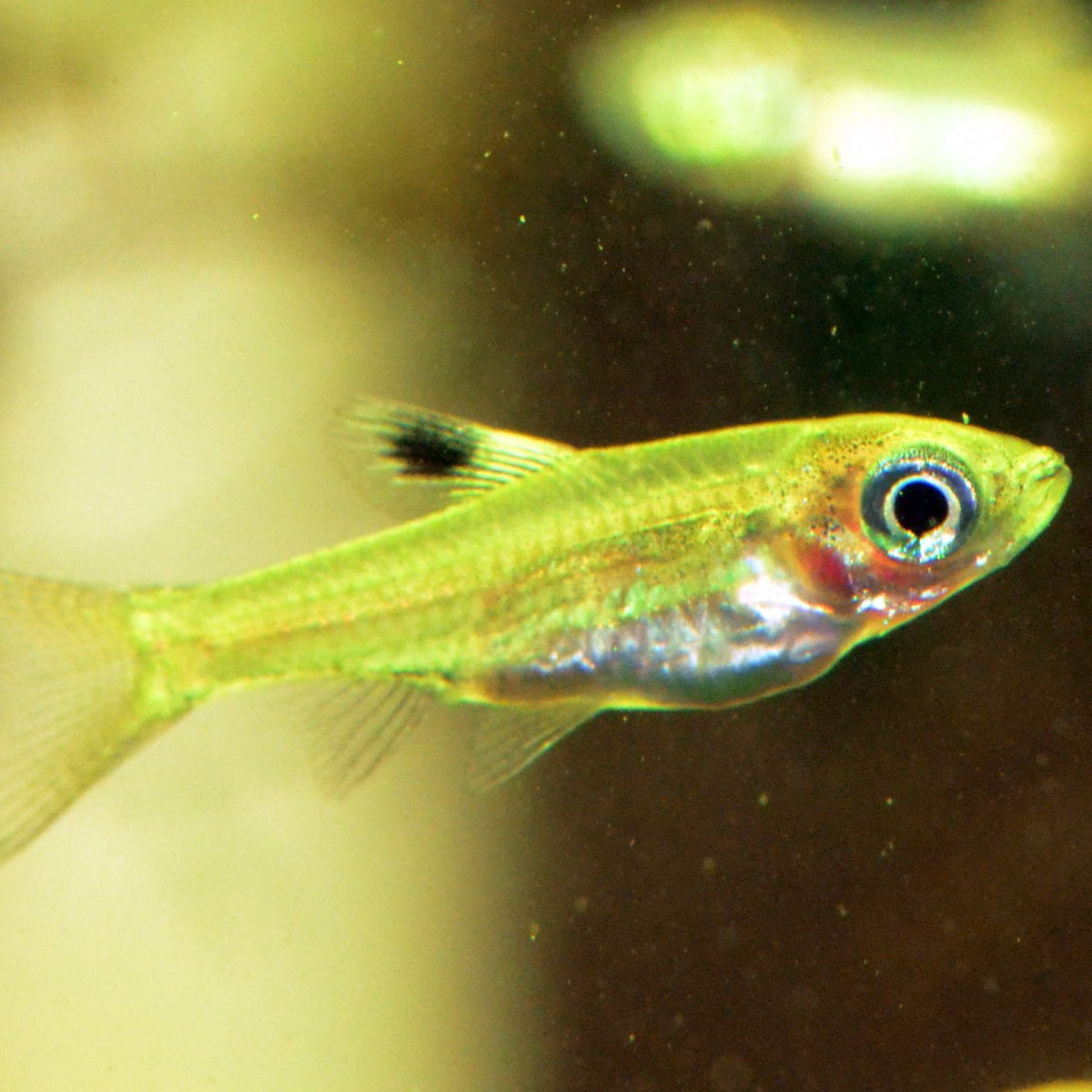The Emerald Eye Rasbora, scientifically known as Rasbora dorsiocellata (though sometimes still referred to as Brevibora dorsiocellata), is a small and captivating freshwater fish native to Southeast Asia, including regions like Malaysia, Indonesia, and possibly Thailand and Cambodia. They are a popular choice for nano and community aquariums due to their peaceful nature and striking appearance, particularly their bright emerald-green eyes.
Appearance:
- They have aslender, silvery body that can sometimes display a yellowish or pinkish hue depending on lighting and conditions.
- Their most distinctive feature is their vibrant emerald-green eye, which catches the light beautifully.
- The dorsal fin is typically yellowish with a prominent black spot or marking, which gives them their alternate name, Eyespot Rasbora.
- Males and females are generally similar in appearance, although males may be slightly slimmer and more brightly coloured, especially during breeding periods.
Size:
- Emerald Eye Rasboras are small fish, typically reaching a maximum size of around 2-3 cm (0.8-1.2 inches).
Tank Requirements:
- Tank Size: A minimum tank size of 40 liters (around 10 gallons) is suitable for a small school, but larger tanks are always better for their well-being and to observe more natural behaviours.
- Substrate: A dark-coloured substrate can help to enhance their colours and reduce stress. Sand or fine gravel is appropriate.
- Décor: They thrive in a densely planted aquarium with plenty of hiding places provided by live plants (like Java moss, Java fern, Anubias), driftwood, and leaf litter. This mimics their natural habitat and provides security, reducing shyness.
- Filtration: A gentle filtration system is preferred as they come from slow-moving waters. Avoid strong currents.
- Lighting: They prefer dim to moderate lighting. Floating plants can help diffuse the light.
- Water Parameters:
- Temperature: 22-26°C (72-79°F)
- pH: 5.0-7.5 (they can adapt to a slightly wider range, but slightly acidic to neutral is ideal)
- Hardness: Soft to moderately hard (50-150 ppm or 3-8 dGH)
Temperament and Tank Mates:
- Emerald Eye Rasboras are peaceful and social fish.
- They are shoaling fish and should be kept in groups of at least 8-10 individuals to feel secure and display their natural behaviors. Larger groups will result in more confident and active fish with better coloration.
- They are excellent for community tanks with other small, peaceful fish that share similar water parameters, such as:
- Other small rasboras (e.g., Chili Rasbora, Harlequin Rasbora)
- Small tetras (e.g., Neon Tetras, Cardinal Tetras)
- Peaceful bottom dwellers (e.g., Corydoras catfish, small loaches)
- Dwarf cichlids (e.g., Apistogramma species, but ensure the cichlids are not too boisterous)
- Small livebearers (e.g., Endler's Livebearers, Guppies)
- They are generally safe with shrimp, although they might occasionally eat very small fry.
- Avoid housing them with large or aggressive fish that could intimidate or prey on them.
Diet:
- Emerald Eye Rasboras are omnivores with a preference for small, meaty foods.
- In the aquarium, they will accept high-quality flake food and micro-pellets.
- Supplement their diet with small live or frozen foods such as brine shrimp, daphnia, bloodworms, and microworms to keep them healthy and enhance their colours.
- Feed them small amounts 2-3 times a day.
Breeding:
- Breeding Emerald Eye Rasboras in a home aquarium is possible but requires specific conditions.
- A separate breeding tank with soft, slightly acidic water and a temperature at the higher end of their range (around 24-26°C or 75-79°F) is recommended.
- Provide fine-leaved plants or a spawning mop for them to lay their eggs on.
- The adults will scatter small, adhesive eggs. They do not exhibit parental care and may eat the eggs, so it's best to remove the adults after spawning.
- The eggs typically hatch within 24-72 hours, and the fry will be very small, requiring infusoria or other tiny food sources initially, followed by baby brine shrimp as they grow.
Emerald Eye Rasboras are a delightful addition to a well-maintained aquarium, bringing subtle beauty and peaceful activity to the underwater landscape. Their small size makes them ideal for nano tanks, and their schooling behaviour adds a dynamic element to any community setup.
![Eco Tech Advanced Reptile Thermostat - Dimming - Dual Electronic Thermostat.]()




